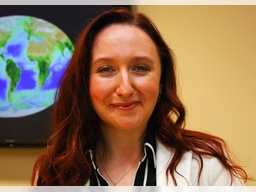Colloquium: Dr. Susanne Craig | NASA
In-Person PHYS 401
Location
Physics : 401
Date & Time
November 8, 2023, 11:00 am – 12:00 pm
Description
TITLE: "Phytoplankton, Photons, and Climate: Using Machine Learning and Autonomous Platform to Understand Ocean Biology’s Role in the Earth System”
ABSTRACT: Phytoplankton, the free floating, photosynthetic biota of water bodies, play fundamental roles in aquatic food webs, atmospheric carbon dioxide uptake, and the burial of carbon to the deep ocean for climate-relevant time scales. In addition to these roles, phytoplankton emit a complex suite of volatile organic compounds (VOCs), which, under certain conditions,
ABSTRACT: Phytoplankton, the free floating, photosynthetic biota of water bodies, play fundamental roles in aquatic food webs, atmospheric carbon dioxide uptake, and the burial of carbon to the deep ocean for climate-relevant time scales. In addition to these roles, phytoplankton emit a complex suite of volatile organic compounds (VOCs), which, under certain conditions,
are involved in the formation of aerosols that may play a significant role in atmospheric radiative forcing. The advent of satellite remote sensing of ocean color in the late 1970s revolutionized our understanding of phytoplankton dynamics in the water bodies of the Earth, and we now rely upon such satellites to understand the response of these ocean ecosystems to a changing climate. One of the challenges of using ocean color is the atmospheric correction process in which the contribution of the atmosphere to the signal measured by satellites is subtracted using a combination of measurements and models. This approach works well over large swaths of the ocean but often fails in coastal and shelf seas, and over inland waters – regions that are the most vulnerable to climate change and anthropogenic influence. In this presentation, we demonstrate the feasibility of using a
Bayesian machine learning approach to retrieve ecological and biogeochemical information in scenarios which are, otherwise, intractable to conventional atmospheric correction approaches. These results will then be discussed in the context of two related research projects: i) Adapting our ML approaches to understand what groups of phytoplankton are present in bulk natural assemblages; and ii) a newly funded project to develop an uncrewed
aerial vehicle (UAV) to simultaneously measure ocean color and metrics of atmospheric chemistry. These measurements will provide fundamental insight into the relationships between phytoplankton types (taxa), the types and fluxes of VOCs they are associated with, and their role in the formation of climate-relevant secondary organic aerosols.
